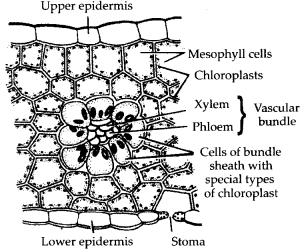The pH of the space of thylakoid of isolated chloroplast is decreased and then transferred in the dark to a pH-8 solution. The result would most likely be:
I.
The isolated chloroplasts will make ATP.
II.
The Calvin cycle will be activated.
III.
Cyclic photophosphorylation will occur.
1.
Only I
2.
Only I and II
3.
Only I and III
4.
Only II and III
Photorespiration rates are increased by:
| I: | lowered availability of carbon dioxide |
| II: | increased availability of oxygen |
| III: | increased temperature |
| 1. | Only I and II | 2. | Only I and III |
| 3. | Only II and III | 4. | I, II and III |
The ATP synthase complexes in a plant cell are located:
| I: | in the thylakoid membrane |
| II: | in the plasma membrane |
| III: | in the inner mitochondrial membrane |
| 1. | I and II only | 2. | I and III only |
| 3. | II and III only | 4. | I, II and III |
A possible purpose of photorespiration may be:
| 1. | assimilation of nitrate from the soil |
| 2. | translocation of carbohydrates |
| 3. | enhanced PGR efficiency |
| 4. | differentiation of plant cells |
The following diagram shows bundle sheath cells with “special” types of chloroplasts. What is special about them?

| 1. | They are larger than normal size |
| 2. | They are agranal |
| 3. | They are dimorphic |
| 4. | Calvin cycle cannot take place in them |
In chloroplasts, protons are actively pumped from
| 1. | the intermembrane space to the matrix. |
| 2. | the matrix to the stroma. |
| 3. | the stroma to the thylakoid space. |
| 4. | the thylakoid space to the intermembrane space. |
The following diagram shows the photosynthetic carbon cycle. A and B can respectively be:
| 1. | Pyruvate; malate or aspartate |
| 2. | Phoshoglycerate; fumarate or aspartate |
| 3. | Phosphoenol pyruvate; malate or aspartate |
| 4. | Phosphoenol pyruvate; fumarate or aspartate |
The relationship between photosynthesis and respiration can be best described as:
| 1. | Photosynthesis and respiration are reversal of each other in biochemical pathways. |
| 2. | Photosynthesis stores energy in complex organic molecules, while respiration releases it. |
| 3. | Respiration occurs only in animals and photosynthesis occurs only in plants. |
| 4. | Respiration results in formation of ATP but photosynthesis can only use them. |
Identify the incorrect statement regarding the enzyme PEP carboxylase:
| 1. | PEP carboxylase has a lower Km for bicarbonate ions, hence, higher affinity — than RuBisCO. |
| 2. | O2 is a very poor substrate for this enzyme. |
| 3. | It plays an important role in C4 cycle but not in CAM plants. |
| 4. | PEP carboxylase is also significant in non-photosynthetic metabolic pathways. |
What can occur during both photosynthesis and respiration?
I: The reduction of oxygen that forms water.
II: Formation of ATP by chemiosmosis
| 1. | Only I | 2. | Only II |
| 3. | Both I and II | 4. | None |








